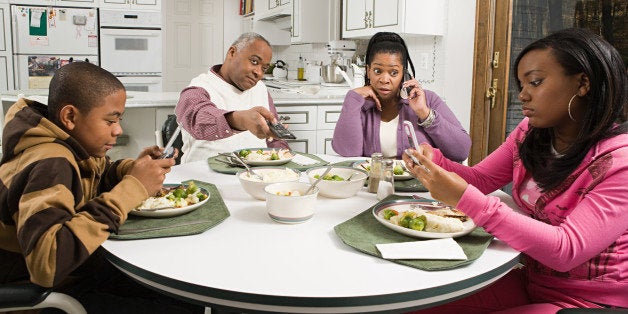
These days, it's hard to hang out with parents of teenagers without hearing disparaging comments about how digital devices are devouring our kids' time and attention. Or how our driving adolescents are driving us mad when they text on the highway, risking life and limb for the sake of a quick LOL or WITW or OMG. All for the sake of what? (SOW? I don't think that one will catch on.) If I hadn't myself sometimes fought the urge to check my own phone in response to that tempting buzzing sound, I'd find this pattern of repeated dangerous behavior something unique to the teen years.
The media is filled with concerning comments about the need for curbing how much time is spent interacting with smartphones, tablets and computers. I'm sure I'm not the only one who's seen a young parent text for blocks with their infant in their arms. Or been in an elevator full of people who, instead of engaging in the informal conversations that connect us to each other in community, are each on their gadgets, typing furiously away.
One thing that emerges from the scientific framework of interpersonal neurobiology that I work in as a psychiatrist and educator is that our self, our mind, is not only a product of our body and its nervous system, including the brain, but it is also a relational process. What this means is that we are not only shaped by what our brain does, but we are created by our relationships.
Relationships can be defined by how we share information with one another. And that exchange of information is a two-way street.
One of the experiences that may arise from texting, for example, is a sense of connection with others, a sense of being seen and even a sense of defining who we are. We are certainly shaped by our relationships -- even through our social media accounts -- which give us a sense of not being alone in the world.
And even more to the point, these communications reveal how our sense of identity can be created by our connections.
As a father, I have found it an exciting and sometimes overwhelming challenge to weave the studies of development -- how we become who we are -- with parenting practices in our home. When our kids were younger, my wife and I decided to try to walk the talk by engaging in what I call reflective dialogues, conversations that focus on the inner nature of our mental lives. This means in our conversations we SIFT our experience by exploring four things that are the life of the mind beneath behavior:
Sensations
Images
Feelings, and
Thoughts.
Too often I have found, both with friends and with patients, that the inner mental life becomes lost amidst a bombardment of external information. The Internet can contribute to this surface attention as it often distracts us from going deeper with each other in real time, focusing instead on one-way visual and auditory inputs that have a sense of being never-ending. If we're not careful, these kinds of surface streams of stimuli can give us a sense of never being done, never being complete, never having accomplished something that is finished. We feel bad, and we are left empty at the surface.
With such a clear vision from modern science, what can we do to make life on the road safer and life at home in the face of the lure of the Internet more connecting? Here are three simple solutions:
1. Engage your own "mindsight" circuits.
When we SIFT the mind, we engage the "mindsight" circuits that support how we have insight into our own inner lives and empathy for the inner experience of others. Mindsight is something that can give us a deeper sense of knowing others, and of knowing ourselves. It helps to begin with yourself, to know your own inner world, so that you begin with making sense of your inner life.
2. Turn off the gadget and turn toward each other.
When we engage with others in reflective dialogues, including with friends and family, we are making time to explore the inner life of each person, to share the SIFTing of our minds and to find meaning in the connection. That's a conversation between two people, an interactive experience that goes beneath the surface to illuminate the inner life of the mind.
3. Focus on reflective dialogues with those around you.
What we focus our attention on shapes the brain. Science would support the view that if we can have more reflective dialogues that engage our mindsight circuitry, we'll have a deeper sense of who we are. And maybe, just maybe, we'll have developed an inner sense of clarity that will make it more likely we won't be so desperate to respond to that phone call or that text while barreling down the road. That would be a great change for everyone.
Learn more about the adolescent brain in Dan's new book Brainstorm: The Power and Purpose of the Teenage Brain.